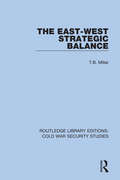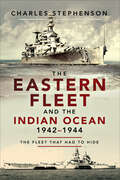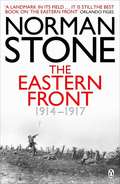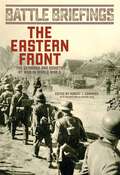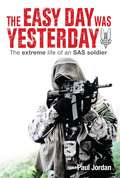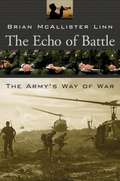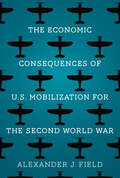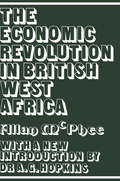- Table View
- List View
The Early Anglo-Saxon Kings
by Tony SullivanThe book takes a new look at the archaeological and literary evidence and focuses on the fragmenting Diocese, provincial and civitas structures of post-Roman Britain. It places events in the context of increased Germanic immigration alongside evidence for significant continuation of population and land use. Using evidence from fifth century Gaul it demonstrates dynamic changes to cultural identities both within and across various groups. Covering the migration period it describes the foundation stories of Hengest and Horsa in Kent, Cerdic and Cynric, first kings of the West Saxons and Ælle founder of the kingdom of the South Saxons. Ælle is the first king Bede describes as holding imperium and the Anglo-Saxon Chronicle calls Bretwalda. Covering the figures of Ceawlin, Æthelberht and Rædwald it ends with the death of Penda, the last great pagan king. As life under Roman authority faded into history we see the emergence of a ‘warband’ culture and the emergence of petty kingdoms. The mead hall replaced crumbling villas and towns as the center of social life. These halls rang with the poems of bards and the stories of great warriors and battles. Arthur and Urien of Rheged. The famous Mons Badonicus and the doomed charge of the Gododdin at Catraeth. A chapter on weapons, armor, warfare and accounts of contemporary battles will help paint a picture of dark age warfare. From the arrival of Saxon mercenaries in the fifth century to the death of Penda, the last pagan king, at Winwaed in 655.
The Early Poetry of Robert Graves: The Goddess Beckons
by Kersnowski Frank L.Like many men of his generation, poet Robert Graves was indelibly marked by his experience of trench warfare in World War I. The horrific battles in which he fought and his guilt over surviving when so many perished left Graves shell-shocked and disoriented, desperately seeking a way to bridge the rupture between his conventional upbringing and the uncertainties of postwar British society. In this study of Graves's early poetry, Frank Kersnowski explores how his war neurosis opened a door into the unconscious for Graves and led him to reject the essential components of the Western idea of reality—reason and predictability. In particular, Kersnowski traces the emergence in Graves's early poems of a figure he later called "The White Goddess," a being at once terrifying and glorious, who sustains life and inspires poetry. Drawing on interviews with Graves's family, as well as unpublished correspondence and drafts of poems, Kersnowski argues that Graves actually experienced the White Goddess as a real being and that his life as a poet was driven by the purpose of celebrating and explaining this deity and her matriarchy.
The Earth Book of Stormgate: A Polesotechnic League Book (POLESOTECHNIC LEAGUE)
by Poul Anderson'Behold these annals from the Discovery and on through the World-Taking.This is the tale as told by Terrans, who walk the earth.Then read.'THE EARTH BOOK OF STORMGATE POUL ANDERSON'S MIGHTY EPIC OF FUTURE HISTORYThe full length story forming the core of the chronicle of the expansion of earthmen into the inhabited galaxy . . . from the Earth Book kept in the Stormgate archive of the great winged race of Ythri.
The Earth Is Weeping: The Epic Story of the Indian Wars for the American West
by Peter CozzensBringing together a pageant of fascinating characters including Custer, Sherman, Grant, and a host of other military and political figures, as well as great native leaders such as Crazy Horse, Sitting Bull, Geronimo, and Red Cloud, The Earth is Weeping—lauded by Booklist as “a beautifully written work of understanding and compassion”—is the fullest account to date of how the West was won…and lost."[S]ets a new standard for Western Indian Wars history..." —Stuart Rosebrook, True West MagazineWith the end of the Civil War, the nation recommenced its expansion onto traditional Indian tribal lands, setting off a wide-ranging conflict that would last more than three decades. In an exploration of the wars and negotiations that destroyed tribal ways of life even as they made possible the emergence of the modern United States, Peter Cozzens gives us both sides in comprehensive and singularly intimate detail. He illuminates the encroachment experienced by the tribes and the tribal conflicts over whether to fight or make peace, and explores the squalid lives of soldiers posted to the frontier and the ethical quandaries faced by generals who often sympathized with their native enemies.
The Earth Shook, the Sky Burned: A Moving Record of America’s Great Earthquake and Fire: San Francisco, April 18, 1906 [Illustrated Edition]
by William BronsonThe Earth Shook, The Sky Burned is the dramatic, complete account of the San Francisco earthquake of April 18, 1906. In the early morning of that day, the sleeping city was rocked by a violent earth tremor that ravaged buildings, heaved streets, and terrified drowsy residents. But worse was to come: the devastating fire that swept across the city for three days. Nearly 30,000 structures were destroyed, and over a quarter million people were left homeless.The Earth Shook, The Sky Burned is a blow-by-blow account of the four days of devastation, not only in San Francisco, but in its adjacent communities. Among the huge cast are Enrico Caruso, who vowed never to return after the quake; John Barrymore, reportedly shaken from a tryst with a young actress; General Frederick Funston, who directed attempts to halt the spreading fire; and Amadeo Giannini, who saved the Bank of Italy’s gold reserves in his horsecart and founded Bank of America after the fire.Illustrated with over 400 on-the-scene photographs, this memorable book reflects the indomitable spirit and vigor of the people who built the West.“Bronson covers every aspect of the disaster in lucid sinewy prose and the selection of a brilliant gallery of pictures…This must rank as the most moving and comprehensive account of the great disaster ever published.”—Los Angeles Times“A fascinating book, and the pictures are magnificent.”—Chicago Sunday Tribune“The Earth Shook, The Sky Burned will make you quake in your boots. The extraordinary story that began on April 18, 1906, has never been told better than what you will find between these covers.”—Michael McCone, Executive Director, The California Historical Society
The East German Army: The Second Power in the Warsaw Pact (Routledge Library Editions: Cold War Security Studies #23)
by Thomas M. ForsterThis book, first published in 1980, provides a detailed analysis of the East German army in the last decade of the Cold War. It examines the capabilities of the main force, after the Soviet army, in the Soviet Bloc, and shows how it depended on more things than purely military factors and national policies. It focuses the army as part of a society that had been comprehensively militarized through ‘socialist military education’, and shows that it was closely tied to the Soviet army, with no military doctrine of its own. In this way, this book provides an analysis of not just East German domestic policies, over which its army held great sway, but also of Soviet Bloc strategic planning for conflict in Western Europe.
The East-West Strategic Balance (Routledge Library Editions: Cold War Security Studies #24)
by T.B. MillarThis book, first published in 1981, offers an analysis of the ways in which one strategic situation in Cold War politics impinged on another, and the interplay of historical forces and trends shaping national policies and the world pattern of power. Bringing together a wealth of factual and analytical material about the alliance systems built around the two superpowers, it examines the areas that seem most dangerous to the peace of the world, particularly in the Middle East, Asia and Latin America.
The Easter Offensive Of 1972 (Indochina Monographs #5)
by Lt. Gen. Ngo Quang TruongIncludes over 30 maps and illustrationsThis monograph forms part of the Indochina Monograph series written by senior military personnel from the former Army of the Republic of Vietnam who served against the northern communist invasion."In 1968, a U.S. presidential election year, Communist North Vietnam initiated the Tet Offensive, striking at almost all major cities and towns of South Vietnam. This general offensive was eventually defeated by the collective efforts of the Republic of Vietnam, United States and Free World Assistance forces. Four years later, in 1972--again a U.S. presidential election year--North Vietnam threw its entire military might behind an invasion to conquer the South. This time, however, South Vietnam had to fight for survival with only logistics and combat support provided by the United States. Almost all U.S. and Free World Military Assistance combat forces had been withdrawn when the first attacks began on 30 April 1972.By all standards, the Easter Offensive of 1972 was one of North Vietnam's most significant initiatives during the Vietnam War. This all-out effort involved eventually in excess of ten divisions on each side and affected the lives of well over a million South Vietnamese people. During the eight long months of fierce fighting, the Republic of Vietnam Armed Forces put Vietnamization to a severe test.During the period of the Easter Offensive, I had the privilege of participating in some of its major battles, first as IV Corps and then as I Corps commander beginning in early May 1972. I visited many of our combat units as they fought the North Vietnam Army and commanded the RVNAF counteroffensive to retake Quang Tri City. My critical analysis of the enemy 1972 Easter Invasion, therefore, is based almost exclusively on my own personal observations, impressions and interviews with Vietnamese who were directly involved."-Authors' Preface.
The Eastern Fleet and the Indian Ocean, 1942–1944: The Fleet that Had to Hide
by Charles StephensonThe story of the British Eastern Fleet, which operated in the Indian Ocean against Japan, has rarely been told. Although it was the largest fleet deployed by the Royal Navy prior to 1945 and played a vital part in the theater it was sent to protect, it has no place in the popular consciousness of the naval history of the Second World War. So Charles Stephenson’s deeply researched and absorbing narrative gives this forgotten fleet the recognition it deserves. British prewar naval planning for the Far East is part of the story, as is the disastrous loss of the battleship Prince of Wales and battlecruiser Repulse in 1941, but the body of the book focuses on the new fleet, commanded by Admiral Sir James Somerville, and its operations against the Japanese navy and aircraft as well as Japanese and German submarines. Later in the war, once the fleet had been reinforced with an American aircraft carrier, it was strong enough to take more aggressive actions against the Japanese, and these are described in vivid detail. Charles Stephenson’s authoritative study should appeal to readers who have a special interest in the war with Japan, in naval history more generally and Royal Navy in particular.
The Eastern Front 1914-1917
by Norman Stone'Without question one of the classics of post-war historical scholarship, Stone's boldly conceived and brilliantly executed book opened the eyes of a generation of young British historians raised on tales of the Western trenches to the crucial importance of the Eastern Front in the First World War' Niall Ferguson 'Scholarly, lucid, entertaining, based on a thorough knowledge of Austrian and Russian sources, it sharply revises traditional assumptions about the First World War.' Michael Howard
The Eastern Front Air War, 1941–1945: Rare Photographs From Wartime Archives (Images of War)
by Anthony Tucker-JonesThis lavishly illustrated WWII history examines the bitter aerial combat of the Eastern Front through rare wartime photographs and informative text. Though the air war was a major aspect of the Eastern Front conflict, it has long been neglected by historians. Anthony Tucker-Jones&’s photographic history offers a vividly detailed introduction to the subject. With more than 150 archival images—most of which have never been published before—this volume examines Stalin&’s Red Air Force and Hitlers Luftwaffe, their equipment, and the role they played in supporting the war on the ground. Just before Hitler&’s invasion of the Soviet Union, Stalin had decimated the leadership of the Red Air Force in a series of purges. Thousands of Russian fighter aircraft were swiftly destroyed in the German Blitzkrieg. But a remarkable recovery followed as the Red Air Force turned the tide against the ravages of the Luftwaffe to wrestle back air superiority by 1944.
The Eastern Front Campaign: An Operational Level Analysis
by Major David S. WilsonThe Eastern Front, 1941-1945, is one of the biggest and most decisive theaters of operation in modern history, and was the largest theater of war in World War Two. A total force of 9 million Germans and Russians battled on both sides with a combined strength of 590 divisions. Military losses approached 5 million German casualties, and 17 million Russian casualties. Altogether, both sides had an active strength of 13,000 tanks, 18,000 combat aircraft, and 50,000 artillery pieces. With the exception of the massive Allied Combined bombing campaign, the Allied effort of ninety-three divisions in Western Europe against seventy German division pales in comparison.Another interesting point in the Eastern Front was initial nature of German operational maneuver, followed by the evolution of Russian operational maneuver. By 1944, the Russian Army had become experts on operational maneuver, and maximized the principals of war of mass, objective, offense, and maneuver. The German Army against an army four times its size eventually culminated, but not until after four years of intense fighting. Eighty percent of total German casualties were lost on the Eastern front, 4.7 million of 6 million casualties. Further, both sides lost an estimated 65,000 tanks and 60,000 combat aircraft, two-thirds being Russian.The methodology of this analysis is chronological, based on the successive operational campaigns from June 1941 through May 1945. Each campaign lists the order of battle, and then the combat power using Lanchester equations (Frederich W. Lanchester) of military combat. In studying modern war, the Eastern Front is a case study in a maneuver oriented army versus a large attrition based army. With almost six hundred years’ worth of German divisional combat on the Eastern Front, valuable lessons can be learned in studying this theater of war.
The Eastern Front: A History of the Great War, 1914-1918
by Nick LloydThe first major history in fifty years of the often overlooked Eastern Front of the First World War, where a more fluid conflict resulted in the destruction of great empires and the rise of the Soviet Union. <P><P> Writing in the 1920s, Winston Churchill argued that the First World War on the Eastern Front was “incomparably the greatest war in history. In its scale, in its slaughter, in the exertions of the combatants, in its military kaleidoscope, it far surpasses by magnitude and intensity all similar human episodes.” It was, he concluded, “the most frightful misfortune” to fall upon mankind “since the collapse of the Roman Empire before the Barbarians.” Yet Churchill was an exception, and the war in the east has long been seen as a sideshow to the brutal combat on the Western Front. Finally, with The Eastern Front—the first major history of that arena in fifty years—the acclaimed historian Nick Lloyd corrects the record. <P><P> Drawing on the latest scholarship as well as eyewitness reports, diary entries, and memoirs, Lloyd moves from the great battles of 1914 to the final collapse of the Central Powers in 1918, showing how a local struggle between Austria-Hungary and Serbia spiraled into a massive conflagration that pulled in Germany, Russia, Italy, Romania, and Bulgaria. The Eastern Front was a vast theater of war that brought about the collapse of three empires and produced almost endless suffering. As many as sixteen million soldiers and two million civilians were killed or wounded in enormous battles that took place across as much as one hundred kilometers. Unlike in the west, where stalemate ruled the day, the war in the east was fluid, with armies embarking on penetrating advances. Lloyd narrates the repeated invasions of Serbia as well as the great battles between Russian, German, and Austrian forces at Tannenberg, Komarów, Gorlice–Tarnów, and the Masurian Lakes. All along, he takes us into the strategy of the generals who decided the war’s course, from the Germans Ludendorff and Hindenburg to the Austro-Hungarian chief, Conrad von Hötzendorf, to the brilliant Russian Brusilov. <P><P> Perhaps the most radical aspect of the struggle in the east was that the violence was not confined to combatants. The Eastern Front witnessed calculated attacks against civilians that ripped the ethnic and religious fabric of numerous societies, paving the way for the horrors of the Holocaust. Lloyd’s magisterial, definitive account of the war in the east will fundamentally alter our understanding of the cataclysmic events that reshaped Europe and the world. <p> <b>New York Times Bestseller</b>
The Eastern Front: The Germans and Soviets at War in World War II (Battle Briefings)
by Robert EdwardsStackpole&’s Battle Briefings series offers accessible and insightful summaries of battles, commanders, and other military history topics. This volume covers the epic clash between the Germans and Soviets on the Eastern Front during World War II. Highlights include Operation Barbarossa, the massive battles at Stalingrad and Kursk, and the final, desperate resistance of the Germans as the Red Army closed in. Throughout are accounts from the turrets of T-34 and Tiger tanks and from the men who fought, often hand-to-hand, in the snow, mud, and dust of the Eastern Front.
The Eastern Front: War, Myth, and Memory (Routledge Studies in Second World War History)
by Olga Kucherenko Yan MannThe Second World War in Eastern Europe is far from a neglected topic, especially since social, cultural, and diplomatic historians have entered a field previously dominated by operational histories, and produced a cornucopia of new scholarship offering a more nuanced picture from both sides of the front. However, until now, the story has still been disjointed and specialized, whereby military, social, economic, and diplomatic histories continue to give their own separate accounts. This collection of essays attempts to bring these themes into a more cohesive whole that tells a complex, multifaceted story of war on the Eastern Front as it truly was.This is one of the few critical examinations that includes both perspectives and looks at the war as a multi‑front effort. It also reveals how myths are created around military conflicts and have direct relevance to current developments in Europe, linking them to a broader discussion of the Second World War, its impact and utility today. It gives a historical dimension to pressing issues and will be of interest and relevance to history students, policymakers, political scientists, diplomats, and foreign policy experts.The Eastern Front will be a useful reference source, since some chapters rely on extensive new archival research and materials, ego sources, as well as extensive findings of non‑Western scholars, thereby bringing their work to the attention of a broader audience.
The Eastern Gate: War and Peace in Nagaland, Manipur and India's Far East
by Sudeep ChakravartiTraders, Pushers, Soldiers, Spies.A pivot for India&’s Act-East policy. The gateway to a future of immense possibilities from hydrocarbons to regional trade over land and water that could create a new Silk Route. A bulwark against China. A cradle of climate change dynamics and migration. &‘Northeast&’ India, the appellation with which India&’s far-east is known, is all this and more.Alongside hope and aspiration, it is also home to immense ethnic and communal tension, and a decades-old Naga conflict and the high-profile peace process that involves four gateway states—Nagaland, Manipur, Arunachal Pradesh and Assam—and several million people. It&’s among the most militarized zones in the world. It&’s a playground of corruption and engineered violence. Only real peace, and calm in both Myanmar and Bangladesh, will unlock this Eastern gate.A keen observer and frequent chronicler of the region, Sudeep Chakravarti has for several years offered exclusive insights into the Machiavellian—Chanakyan—world of the Naga and other conflicts and various attempts to resolve these. He now melds the skills of a journalist, analyst, historian and ethnographer to offer inside stories and a ringside view to the tortuous, no-holds-barred attempts at resolving conflict.Employing a &‘dispatches&’ style of storytelling, and interviews with rebel leaders, politicians, bureaucrats, policymakers, security specialists and operatives, gunrunners, &‘narcos&’, peace negotiators and community leaders, Chakravarti&’s narrative provides a definitive guide to the transition from war to peace, even as he keeps a firm gaze on the future. The Eastern Gate is a tour de force that captures this story of our times.
The Easy Day Was Yesterday: The Extreme Life of an SAS Soldier (Big Sky Publishing Ser.)
by Paul JordanFrom his cage in a putrid, overcrowded Indian gaol, Paul Jordan reflects on a life lived on the edge and curses the miscalculation that robbed him of his freedom. His childhood, marred by the loss of his father and brother, produce a young man hell bent on being the best of the best - an ambition he achieves by being selected to join the elite SAS. He survives the gut-wrenching training regime, deployment to the jungles of Asia and the horrors of genocide in Rwanda before leaving the army to embark on a career as a security adviser. His new life sees him pursuing criminals and gun-toting bandits in Papua New Guinea and the Solomons, protecting CNN newsmen as the US 7th Cavalry storms into Baghdad with the outbreak of the Iraq War, and facing death on a massive scale as he accompanies reporters into the devastated Indonesian town of Banda Aceh, flattened by the Boxing Day tsunami. During his 24 days in an Indian gaol, Paul Jordan discovers that friendship and human dignity somehow survive the filth and deprivation. This is a personal account of a tough, hardened fighter who suddenly finds himself totally dependent on others for his every need. The Easy Day was Yesterday is fast paced, brutally honest and raw, but laced with dark humour. The core of Paul Jordan's eventful life, however, is the strength of his bonds with family and friends and the ability of the human spirit to survive even the direst adversity.
The Eaves of Heaven
by Andrew X. PhamOne of the Ten Best Books of the Year, Washington Post Book World One of the Los Angeles Times’ Favorite Books of the Year One of the Top Ten National Books of 2008, Portland Oregonian A 2009 Honor Book of the Asian/Pacific American Librarians Association “Few books have combined the historical scope and the literary skill to give the foreign reader a sense of events from a Vietnamese perspective. . . . Now we can add Andrew Pham’s Eaves of Heaven to this list of indispensable books. ” —New York Times Book Review “Searing . . . vivid–and harrowing . . . Here is war and life through the eyes of a Vietnamese everyman. ” —Seattle Times Once wealthy landowners, Thong Van Pham’s family was shattered by the tumultuous events of the twentieth century: the French occupation of Indochina, the Japanese invasion during World War II, and the Vietnam War. Told in dazzling chapters that alternate between events in the past and those closer to the present,The Eaves of Heavenbrilliantly re-creates the trials of everyday life in Vietnam as endured by one man, from the fall of Hanoi and the collapse of French colonialism to the frenzied evacuation of Saigon. Pham offers a rare portal into a lost world as he chronicles Thong Van Pham’s heartbreaks, triumphs, and bizarre reversals of fortune, whether as a South Vietnamese soldier pinned down by enemy fire, a prisoner of the North Vietnamese under brutal interrogation, or a refugee desperately trying to escape Vietnam after the last American helicopter has abandoned Saigon. This is the story of a man caught in the maelstrom of twentieth-century politics, a gripping memoir told with the urgency of a wartime dispatch by a writer of surpassing talent.
The Echo of Battle: The Army's Way of War
by Brian Mcallister LinnIn the face of radically new ways of waging war, Brian Linn surveys the past assumptions--and errors--that underlie the army's many visions of warfare up to the present day. He explores the army's forgotten heritage of deterrence, its long experience with counter-guerrilla operations, and its successive efforts to transform itself. Distinguishing three martial traditions--each with its own concept of warfare, its own strategic views, and its own excuses for failure--he locates the visionaries who prepared the army for its battlefield triumphs and the reactionaries whose mistakes contributed to its defeats.
The Echo of Twilight
by Judith Kinghorn"An enchanting, atmospheric work of historical fiction that is a rich blend of Downton Abbey and Jane Eyre. The Echo ofTwilight is a wonderful novel to curl up with this winter."--BooklistFrom the acclaimed author of The Last Summer, a captivating and moving story of the unlikely relationship between a lady and her maid on the eve of World War I. As I watched him—his long legs striding the narrow path through the heather, his golden hair catching the sun—I had a hideous feeling in the pit of my stomach. For it seemed as though he was already marching away from me. In 1914, despite the clouds of war threatening Europe, Pearl Gibson’s future is bright. She has secured a position as a lady’s maid to a wealthy Northumberland aristocrat, a job that will win her not only respect but an opportunity to travel and live in luxury. Her new life at Lady Ottoline Campbell’s Scottish summer estate is a whirlwind of intrigue and glamour, scandals and confidences—and surprisingly, a strange but intimate friendship with her employer. But when violence erupts in Europe, Pearl and Ottoline’s world is irrevocably changed. As the men in their lives are called to the front lines, leaving them behind to anxiously brace for bad news, Pearl realizes she must share one final secret with her mistress—a secret that will bind them together forever...
The Eclipse Trilogy: Eclipse, Eclipse: Penumbra, and Eclipse: Corona (The Eclipse Trilogy)
by John ShirleyThe complete trilogy in one volume: Tech-savvy resistance fighters battle a twenty-first-century fascist takeover that threatens the entire planet—and beyond . . . In the near future, Russia invades Western Europe, crisis envelops the United States—and a mercenary army overseen by power-hungry theocrats and authoritarians takes advantage of the chaos. But a band of resistance fighters, technologically skilled and as dedicated to freedom as they are to sex, drugs, and rock and roll, intend to do what needs to be done to save humanity from mass-scale genocide—including those humans living in the world&’s first orbiting space colony . . . This volume includes Eclipse, Eclipse: Penumbra, and Eclipse: Corona Praise for The Eclipse Trilogy &“[An] apocalyptic, pop-inflected, rock-driven vision.&” —William Gibson, New York Times–bestselling author of Neuromancer &“Hard to put down.&” —The Washington Post &“John Shirley&’s prophet-in-the-cyberwilderness voice deserves high billing among the best.&” —Roger Zelazny, Nebula Award-winning author of Nine Princes in Amber &“A Goya-esque vision of war-torn western Europe, bombed out and unstable . . . from a resurgence of Russian militarism and the collapse of NATO.&” —Publishers Weekly &“A kaleidoscopic mix of politics, pop, and paranoia.&” —Bruce Sterling, author of Heavy Weather &“Chillingly plausible.&” —Kirkus Reviews
The Economic Consequences of U.S. Mobilization for the Second World War
by Alexander J. FieldA reminder that war is not always, or even generally, good for long-term growth Many believe that despite its destructive character, war ultimately boosts long‑term economic growth. For the United States this view is often supported by appeal to the experience of the Second World War, understood as a triumph of both production and productivity. Alexander Field shows that between 1941 and 1945 manufacturing productivity actually declined, depressed by changes in the output mix and resource shocks from enemy action, including curtailed access to natural rubber and, on the Eastern Seaboard, petroleum. The war forced a shift away from producing goods in which the country had a great deal of experience toward those in which it had little. Learning by doing was only a partial counterbalance to the intermittent idleness and input hoarding that characterized a shortage economy and dragged down productivity. The conflict distorted human and physical capital accumulation and once it ended, America stopped producing most of the new goods. The war temporarily shut down basic scientific research and the ongoing development of civilian goods. U.S. world economic dominance in 1948, Field shows, was due less to the experience of making war goods and more to the country&’s productive potential in 1941.
The Economic Effort of War (Routledge Revivals)
by R. W. ClarkeThe course of economic events from the start of the Second World War satisfied no-one. The housewife was exasperated by the rise in food prices, thousands of workers faced unemployment, and businessmen were bewildered by the flood of regulations and decrees. In this book, first published in 1940, R. W. B. Clarke explores the economic challenges that the UK faced in coping with the war, and possible ways in which these challenges could be resolved or improved. The book is vital reading for students of modern history and economics.
The Economic Problems of Europe: Pre-War and After (Routledge Revivals)
by M. Philips PriceFirst Published in 1928 The Economic Problems of Europe presents a comprehensive overview of the economic and political transformation of Europe since the First World War. European and world problems often tend to be looked upon from the political, diplomatic, naval, or military aspect. Morgan Philips Price attempted to add the economic background and to show the connection between the political rearrangements since the First World War and the material needs of society, markets of the industrialist, the wages of the workman, and the loans of the bankers. He argued that with the growing internationalization of the world economy, the old map of the world is obsolete and the new one, if it is based on frontiers of finance and industry, will be something very different. This book is an essential read for scholars and researchers of economic history, war history, political economy, British economic history and European history.
The Economic Revolution in British West Africa
by Allan McPheeOriginally published in 1926, McPhee's work was the first to establish a framework for understanding the economic development between 1820-1920 in British West Africa.






